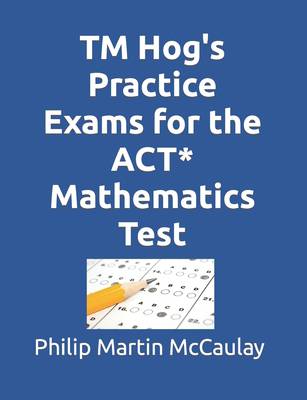
- Retrait gratuit dans votre magasin Club
- 7.000.000 titres dans notre catalogue
- Payer en toute sécurité
- Toujours un magasin près de chez vous
- Retrait gratuit dans votre magasin Club
- 7.000.0000 titres dans notre catalogue
- Payer en toute sécurité
- Toujours un magasin près de chez vous
Description
TM Hog's Practice Exams for the ACT* Mathematics Test contains four complete 60-question, 60-minute sample tests for a total of 240 practice questions with answers and explanations designed to measure the mathematical skills students have typically acquired in courses taken by the end of 11th grade. Pre-Algebra (23%): basic operations using whole numbers, decimals, fractions, and integers; place value; square roots and approximations; the concept of exponents; scientific notation; factors; ratio, proportion, and percent; linear equations in one variable; absolute value and ordering numbers by value; elementary counting techniques and simple probability; data collection, representation, and interpretation; and understanding simple descriptive statistics Elementary Algebra (17%): properties of exponents and square roots, evaluation of algebraic expressions through substitution, using variables to express functional relationships, understanding algebraic operations, and the solution of quadratic equations by factoring Intermediate Algebra (15%): quadratic formula, rational and radical expressions, absolute value equations and inequalities, sequences and patterns, systems of equations, quadratic inequalities, functions, modeling, matrices, roots of polynomials, and complex numbers Coordinate Geometry (15%): graphing and the relations between equations and graphs, including points, lines, polynomials, circles, and other curves; graphing inequalities; slope; parallel and perpendicular lines; distance; midpoints; and conics Plane Geometry (23%): properties and relations of plane figures, including angles and relations among perpendicular and parallel lines; properties of circles, triangles, rectangles, parallelograms, and trapezoids; transformations; the concept of proof and proof techniques; volume; and applications of geometry to three dimensions Trigonometry (7%): understanding trigonometric relations in right triangles; values and properties of trigonometric functions; graphing trigonometric functions; modeling using trigonometric functions; use of trigonometric identities; and solving trigonometric equations
Spécifications
Parties prenantes
- Auteur(s) :
- Editeur:
Contenu
- Nombre de pages :
- 396
- Langue:
- Anglais
- Collection :
Caractéristiques
- EAN:
- 9798422940462
- Date de parution :
- 25-02-22
- Format:
- Livre broché
- Format numérique:
- Trade paperback (VS)
- Dimensions :
- 189 mm x 246 mm
- Poids :
- 703 g

Les avis
Nous publions uniquement les avis qui respectent les conditions requises. Consultez nos conditions pour les avis.






